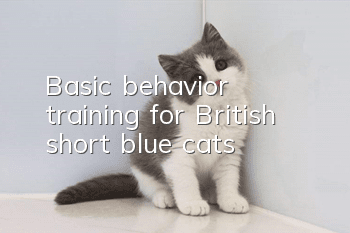Symptoms and treatments for spontaneous cystitis in cats

In the past, we always believed that hematuria, frequent urination, and difficulty in urination in cats indicate stone obstruction. In fact, recent studies have found that about 50 to 60% of cases are spontaneous bladder problems. Feline spontaneous cystitis is a torture for both the cat and the owner, because the cat will have various painful symptoms such as frequent urination, painful urination, hematuria, and difficulty urinating. The cause of spontaneous cystitis was not clear in previous pathological studies. Now, with the development of medicine, there is a new understanding of spontaneous cystitis in cats.
1. Causes of spontaneous cystitis in cats
It is currently believed that the cause of FIC may be related to the cat’s living environment and emergency stress, which in turn affects the nervous system and endocrine system. The role of the sympathetic nervous system is to release endocrine hormones such as norepinephrine and epinephrine, while the adrenal glands (one of the organs of the endocrine system) release cortisol and other steroid hormones. Identifying FIC by an overexcited sympathetic nervous system or a blunted endocrine response does not appear to affect healthy cats. Any treatment planned to reduce the output of the sympathetic nervous system will be very helpful in reducing the clinical symptoms of FIC. important. To put it simply, when external stimulation is transmitted to the brain, it will cause a specific physiological response.
Studies have also pointed out that other possible factors causing FIC include calicivirus infection, bovine herpes virus type IV infection (BHV-4), immune problems, food types (especially dry food with high mineral content), genetics factors or changes in the bladder epithelial cell wall. There is no breed or gender difference in the incidence of FIC. It occurs in both male and female cats. Some scholars have pointed out that obese cats and Persian cats are more likely to develop FIC. Cats after sterilization surgery seem to have a higher risk of FIC. About 50% of cystitis cases in cats aged 1 to 10 years are FIC, while only about 5% of cases in cats over 10 years old are FIC, so FIC is more common in young or prime-age cats.
2. Symptoms of spontaneous cystitis in cats
Urinating on the ground is one of the most common symptoms. According to foreign research statistics, about 1% of cats may suffer from feline spontaneous cystitis, and most of the cats suffering from spontaneous cystitis are between 1 and 10 years old. Spontaneous cystitis can occur in cats of any breed and gender, and cats that have been neutered appear to have a higher incidence. Cats suffering from spontaneous cystitis usually have hematuria, frequent urination, and difficulty urinating. They will exert special force when urinating. Some cats will scream because of pain during urination. Due to frequent urination, the hair around the genitals will be dirty, so the cat will have Frequent licking of hair near the genitals.
In addition to the above symptoms, the most common symptom is peeing everywhere. I used to think that cats pee everywhere.Urinating is just an abnormal behavior, but recent studies have found that most of it is related to spontaneous cystitis. Because these symptoms are very similar to those of urinary tract stones and urinary tract infections, it is often difficult to distinguish them based on clinical symptoms alone.
Most cats suffering from spontaneous cystitis will still have normal spirits and appetite if there is no urethral obstruction. Only when urethral obstruction occurs will more serious symptoms appear, such as lethargy, poor appetite, Vomiting and inactivity. This kind of obstruction is usually more likely to occur in male cats. This is mainly because the urethra of female cats is shorter and wider, making it less prone to obstruction.
3. Diagnosis
1. Physical examination
Cats will urinate frequently due to bladder pain, and the amount of urine each time is just a little. Therefore, when going to the hospital for examination, a small or anuric bladder is usually palpated. If urethral obstruction occurs, abdominal palpation is required. It causes pain, the abdomen is tight and hard, a distended and firm bladder can be palpated, and the appearance appears weak and dehydrated.
2. Urinalysis
Improper urine samples will affect the test results. It is recommended to use fresh urine samples obtained by bladder puncture or catheterization and conduct tests immediately. Spontaneous cystitis may be complicated by urolithiasis, so if the urine residue is When a large number of crystals are detected, urolithiasis should be diagnosed first, and appropriate treatment and prescribed feed should be given. If symptoms still persist, the possibility of spontaneous cystitis must be considered. If hematuria or proteinuria appears in the urine sample of a cat that urinates indiscriminately, the possibility of spontaneous cystitis must be considered.
3. Complete blood count and serum biochemistry
Most cases without urethral obstruction will show normal test results. If obstruction occurs, post-renal azotemia, metabolic acidosis, and hyperkalemia will appear.
4. B-ultrasound examination
B-ultrasound examination of some cats with FIC shows swollen bladder wall, and this can be used to rule out bladder stones, tumors, prostate diseases, etc.
5. X-ray examination
Exclude urethral and bladder stones. Special contrast X-ray examination: Structural abnormalities of the bladder may be seen, such as urinary diverticula of the bladder.
6. Cystoscopy
Examine the inner wall of the urethra and bladder, which requires anesthesia to look for small stones, polyps, and tumors, which may be difficult to evaluate with other imaging modalities.
4. Treatment
The current goal of FIC treatment is to reduce symptom severity and increase symptom-free time. The treatment of FIC mainly depends on the following two aspects:
1. Behavioral therapy
As mentioned above, the reasons for FIC may mainly be related to the environment.It is related to stress, so the most direct way to treat it is to reduce environmental stress.
You can start with the cat litter box Auchan's treatment of the cat litter box. You can place it in a quiet place where you are willing to go. The number of cat litter boxes is one more than the number of cats. Place cat litter boxes in different places. Clean the cat litter twice a day. Change cat litter regularly and every week. The litter box should be large enough and the depth of cat litter should be sufficient. Use odorless cat litter.
2. Drug treatment
Analgesic tricyclic antidepressant amitriptyline: Helps relieve pain and uneasiness, and also has anti-inflammatory and repairing effects on the inner wall of the bladder. The dose is 2.5~12.5 mg per day, taken orally, and given at night. Adjust long-term treatment to the environment.
N-Acetyl-D-Glucosamine: This product is the precursor substance of glycosaminoglycan (GAG). It can strengthen the GAG layer of the inner wall of the bladder and reduce the impact of toxic substances on the bladder. It plays a protective role in the bladder mucosa. The dose for initial cases is 125 mg, taken orally, twice a day, for at least two weeks. For recurrent cases, the dose is 125 mg/kg, taken orally, once a day, for long-term administration.
- Will Ragdoll cats’ fur become darker in winter?
- What kind of special litter box should be prepared for pet cats?
- Why do cats eat dead leaves?
- Is it good to neuter male cats?
- Is it okay for cats to eat one kind of cat food for a long time?
- Will impure folded-eared cats get sick?
- Do cats cry after being abandoned?
- Can hair in a cat's eye come out on its own?
- How to change a timid cat?
- The cat's cheek is swollen



